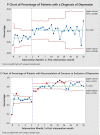Increasing Recognition and Diagnosis of Adolescent Depression: Project RedDE: A Cluster Randomized Trial
- PMID: 31745520
- PMCID: PMC6805099
- DOI: 10.1097/pq9.0000000000000217
Increasing Recognition and Diagnosis of Adolescent Depression: Project RedDE: A Cluster Randomized Trial
Abstract
Adolescent depression causes appreciable morbidity and is underdiagnosed in primary care. This study investigated whether a quality improvement collaborative (QIC) increases the frequency of adolescent depression diagnoses, thus reducing missed diagnoses.
Methods: During a cluster-randomized clinical trial, a national cohort of primary care pediatric practices worked in different orders based on randomization to improve performance on each of three different diagnoses; one was increasing adolescent depression diagnoses. While improving their first diagnosis during an 8-month action period, practices collected control data for a different diagnosis. In two subsequent 8-month periods, practices worked to improve two additional diagnoses and continued to provide data on the ability to sustain and maintain improvements. The QIC intervention included day-long video conferences, transparent data sharing, analysis of failures, QI coaching, and tools to help improve diagnostic performance, including the Patient Health Questionnaire-9 Modified. The primary outcome was the measured frequency of depression diagnoses in adolescent health supervision visits compared via generalized mixed-effects regression models.
Results: Forty-three practices were randomized with 31 in the final analysis. We included 3,394 patient visits in the control and 4,114 in the intervention phases. The adjusted percentage of patients with depression diagnoses increased from 6.6% in the control to 10.5% in intervention phase (Risk Difference (RD) 3.9%; 95% CI 2.4%, 5.3%). Practices sustained these increases while working on different diagnoses during the second (RD -0.4%; 95% CI -2.3, 1.4%), and third action periods (RD -0.1%; 95% CI -2.7%, 2.4%).
Conclusions: A QIC intervention can sustainably increase adolescent depression diagnoses.
Copyright © 2019 the Author(s). Published by Wolters Kluwer Health, Inc.
Figures



References
-
- Center for Behavioral Health Statistics and Quality. 2015. Behavioral health trends in the United States: Results from the 2014 National Survey on Drug Use andHealth (HHS Publication No. SMA 15-4927, NSDUH Series H-50). Retrieved from https://www.samhsa.gov/data/sites/default/files/NSDUH-FRR1-2014/NSDUH-FR....
-
- Garrison CZ, Addy CL, Jackson KL, et al. Major depressive disorder and dysthymia in young adolescents. Am J Epidemiol. 1992;135:792–802.. - PubMed
-
- Whitaker A, Johnson J, Shaffer D, et al. Uncommon troubles in young people: prevalence estimates of selected psychiatric disorders in a nonreferred adolescent population. Arch Gen Psychiatry. 1990;47:487–496.. - PubMed
-
- Lewinsohn PM, Hops H, Roberts RE, et al. Adolescent psychopathology: I. prevalence and incidence of depression and other DSM-III-R disorders in high school students. J Abnorm Psychol. 1993;102:133–144.. - PubMed
LinkOut - more resources
Full Text Sources
Miscellaneous
